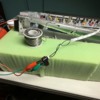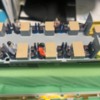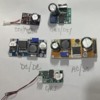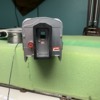Let’s start off by this is not a criticism for people who like to use control boards and have complex lighting. This is for those of us who just want to convert from incandescent to LED lighting.
purchase the LED lighting strip 24 V on Amazon. If you use this strip no conversion boards are needed. self regulates and converts over to DC automatically. Since the LED lighting is 24 V we do not need to worry about polarity or voltage
step one remove the car, body and unscrew and remove the MTH LED lighting strip unplugged the strip and keep the connector and wire intact. we will cut the plug off the one end and solder to the strip before we place the strip in the car. Take your LED strip that you have purchased unroll to the length that you want and cut it at the strips cut point that are clearly marked. This is also where you will solder. Take the LED spring connector and pigtail cut the plug off the one end and solder those two wires to the LED strip. Remove the 3M backing tape on the LED strip and install in the roof of the car. You’re done put the car back together you have LED lighting.
if you have any questions please email me direct, I will be glad to help.


























